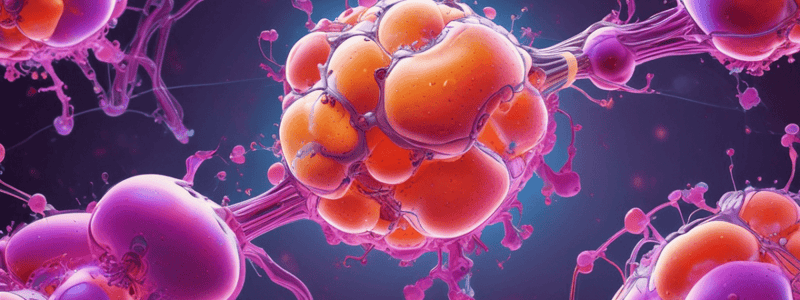Podcast
Questions and Answers
Which group is transferred when the oxygen of the nucleophile attacks the β position of ATP?
Which group is transferred when the oxygen of the nucleophile attacks the β position of ATP?
- AMP
- Pyrophosphoryl (correct)
- Phosphate (—OPO32–)
- Pyrophosphate
What is the cellular ATP concentration like in most cells?
What is the cellular ATP concentration like in most cells?
- Below equilibrium concentration
- At equilibrium concentration
- Usually far above equilibrium concentration (correct)
- Dependent on the cell's type
Why does the hydrolysis of PhosphoEnolPyruvate (PEP) catalyzed by pyruvate kinase have a large standard free energy of hydrolysis?
Why does the hydrolysis of PhosphoEnolPyruvate (PEP) catalyzed by pyruvate kinase have a large standard free energy of hydrolysis?
- Products being destabilized via resonance
- Products undergoing less favorable solvation
- Resonance stabilization and favorable solvation of the products (correct)
- Lack of electrostatic repulsion within reactant molecules
What happens when the oxygen of the nucleophile attacks the α position of ATP?
What happens when the oxygen of the nucleophile attacks the α position of ATP?
What kind of group is transferred when attacking the γ position of ATP with oxygen of the nucleophile?
What kind of group is transferred when attacking the γ position of ATP with oxygen of the nucleophile?
All the factors below contribute to the large standard free energy of hydrolysis in PEP catalyzed by pyruvate kinase EXCEPT
All the factors below contribute to the large standard free energy of hydrolysis in PEP catalyzed by pyruvate kinase EXCEPT
What is the most highly oxidized form of carbon found in living systems?
What is the most highly oxidized form of carbon found in living systems?
In biochemical oxidation-reduction reactions, how many electrons are typically involved in transfer?
In biochemical oxidation-reduction reactions, how many electrons are typically involved in transfer?
What accompanies electron transfer in order to keep charges in balance?
What accompanies electron transfer in order to keep charges in balance?
In dehydrogenases, like lactate dehydrogenase, how does the reaction typically proceed?
In dehydrogenases, like lactate dehydrogenase, how does the reaction typically proceed?
Which enzyme catalyzes the reaction of lactate to pyruvate in cells?
Which enzyme catalyzes the reaction of lactate to pyruvate in cells?
Which flavin cofactor allows single or double electron transfers?
Which flavin cofactor allows single or double electron transfers?
What forms when FAD or FMN accepts only one hydrogen atom?
What forms when FAD or FMN accepts only one hydrogen atom?
What vitamin is the isoalloxazine ring of FAD and FMN derived from?
What vitamin is the isoalloxazine ring of FAD and FMN derived from?
What deficiency leads to Stomatitis?
What deficiency leads to Stomatitis?
Why does the hydrolysis of 1,3-bisphosphoglycerate (1,3-BPG) have a large standard free energy of hydrolysis?
Why does the hydrolysis of 1,3-bisphosphoglycerate (1,3-BPG) have a large standard free energy of hydrolysis?
Which of the following statements about the hydrolysis of phosphocreatine (PCr) is correct?
Which of the following statements about the hydrolysis of phosphocreatine (PCr) is correct?
What is the overall result of the flow of phosphoryl groups catalyzed by kinases?
What is the overall result of the flow of phosphoryl groups catalyzed by kinases?
What is the significance of the hydrolysis of low-energy phosphate compounds?
What is the significance of the hydrolysis of low-energy phosphate compounds?
What is the primary factor that influences the actual free-energy change (ΔG) of ATP hydrolysis, in addition to the standard free energy (ΔG°')?
What is the primary factor that influences the actual free-energy change (ΔG) of ATP hydrolysis, in addition to the standard free energy (ΔG°')?
In the two-step reaction catalyzed by ATP-dependent glutamine synthetase, what is the first step?
In the two-step reaction catalyzed by ATP-dependent glutamine synthetase, what is the first step?
In the context of ATP hydrolysis, what is the role of the enzyme that catalyzes the reaction?
In the context of ATP hydrolysis, what is the role of the enzyme that catalyzes the reaction?
What are the common redox cofactors that allow two-electron transfer in biological systems?
What are the common redox cofactors that allow two-electron transfer in biological systems?
What vitamin is the pyridine-like rings of NAD and NADP derived from?
What vitamin is the pyridine-like rings of NAD and NADP derived from?
How can the formation of NADH be monitored using spectrophotometry?
How can the formation of NADH be monitored using spectrophotometry?
Which type of ion is accepted by NAD+ and NADP+ during reduction reactions?
Which type of ion is accepted by NAD+ and NADP+ during reduction reactions?
Which enzyme uses NADH as a cofactor for the transfer of electrons in cellular reactions?
Which enzyme uses NADH as a cofactor for the transfer of electrons in cellular reactions?
Flashcards are hidden until you start studying

